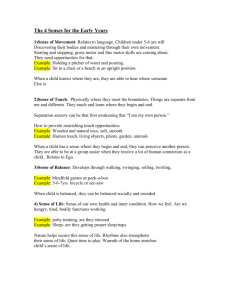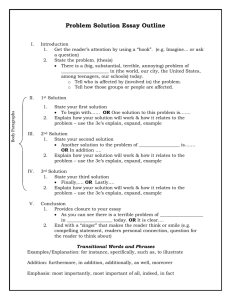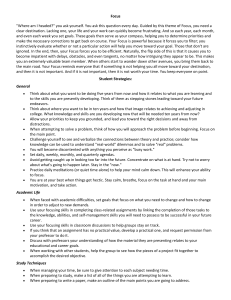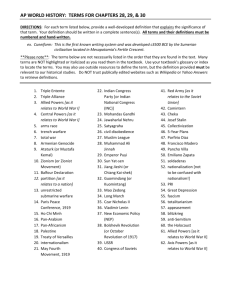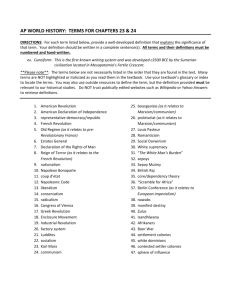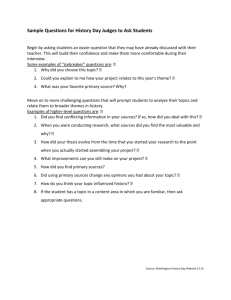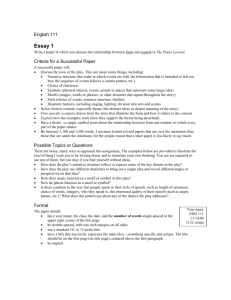UNIVERSITY OF KENT SECTION 1: MODULE SPECIFICATIONS
advertisement
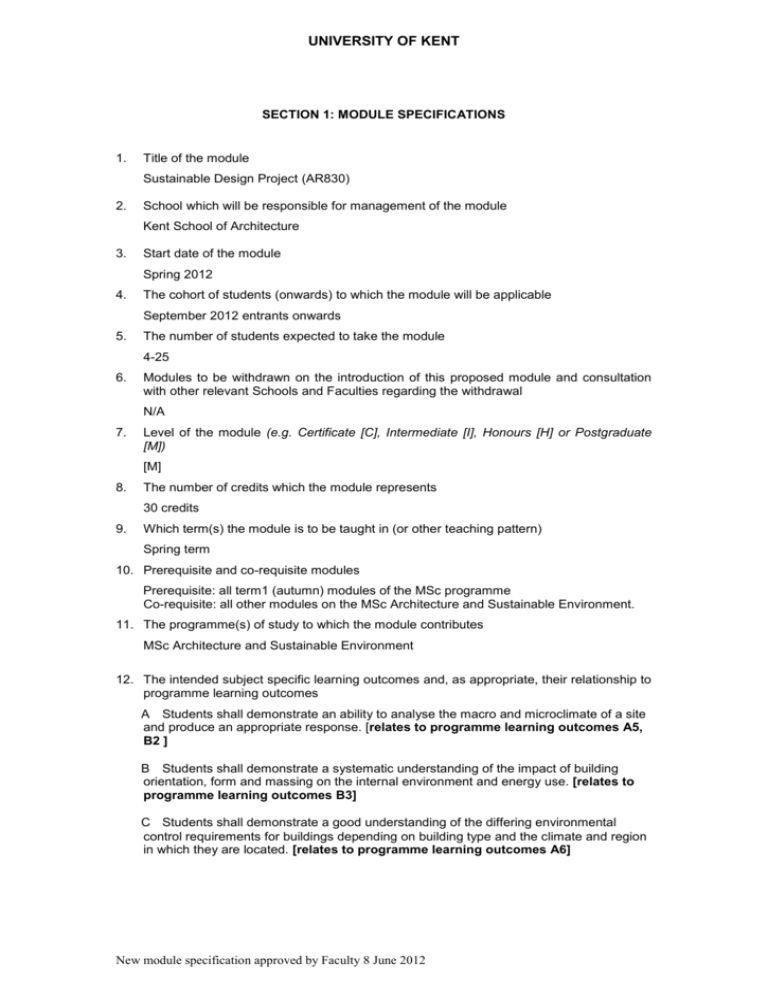
UNIVERSITY OF KENT SECTION 1: MODULE SPECIFICATIONS 1. Title of the module Sustainable Design Project (AR830) 2. School which will be responsible for management of the module Kent School of Architecture 3. Start date of the module Spring 2012 4. The cohort of students (onwards) to which the module will be applicable September 2012 entrants onwards 5. The number of students expected to take the module 4-25 6. Modules to be withdrawn on the introduction of this proposed module and consultation with other relevant Schools and Faculties regarding the withdrawal N/A 7. Level of the module (e.g. Certificate [C], Intermediate [I], Honours [H] or Postgraduate [M]) [M] 8. The number of credits which the module represents 30 credits 9. Which term(s) the module is to be taught in (or other teaching pattern) Spring term 10. Prerequisite and co-requisite modules Prerequisite: all term1 (autumn) modules of the MSc programme Co-requisite: all other modules on the MSc Architecture and Sustainable Environment. 11. The programme(s) of study to which the module contributes MSc Architecture and Sustainable Environment 12. The intended subject specific learning outcomes and, as appropriate, their relationship to programme learning outcomes A Students shall demonstrate an ability to analyse the macro and microclimate of a site and produce an appropriate response. [relates to programme learning outcomes A5, B2 ] B Students shall demonstrate a systematic understanding of the impact of building orientation, form and massing on the internal environment and energy use. [relates to programme learning outcomes B3] C Students shall demonstrate a good understanding of the differing environmental control requirements for buildings depending on building type and the climate and region in which they are located. [relates to programme learning outcomes A6] New module specification approved by Faculty 8 June 2012 UNIVERSITY OF KENT D Students shall demonstrate an ability to use theoretical knowledge and prediction methodologies to create appropriate design strategies. [relates to programme learning outcomes A3, B4, C1, C2] E Students shall demonstrate an ability to understand, analyse and reflect upon their design with respect to the internal environmental conditions created in a particular climate and location. [relates to programme learning outcomes C4] F Students shall demonstrate an ability to work in design teams which take into account the approaches and the needs of different professional disciplines.. [relates to programme learning outcomes C5] 13. The intended generic learning outcomes and, as appropriate, their relationship to programme learning outcomes A Students shall demonstrate an understanding of advanced research principles, the ability to analyse source materials, and form original hypotheses. [relates to programme learning outcomes D2] B Students shall demonstrate the ability to produce sophisticated and imaginative solutions to demanding problems. [relates to programme learning outcomes D3] C Students shall demonstrate the ability to conduct project work independently or within a team of research collaborators. [Relates to Programme Learning Outcomes D4-5] 14. A synopsis of the curriculum Students explore passive means of environmental control to achieve low energy and comfort under varying climatic conditions. Advanced techniques and methodologies for analysis of local climatic conditions, site, and building proposals lead to the development of environmental design strategies. The influence of materials, form and construction on environmental performance is examined with reference to precedents and benchmarks. Students prepare proposals, firstly in the form of design strategies, for creating comfort in a hostile external environment. Orientation, shading requirements, thermal mass etc will need to be considered. A clear and rigorous rationale for the design strategies will form part of this work The main task for students is to prepare environmental design strategies and design proposals for a low-energy building to meet the highest sustainable design standards. 15. Indicative Reading List Clegg, Peter et al. (2007) Feilden Clegg Bradley: the environmental handbook. The Right Angle. Hindrichs, Dirk U and Daniels, Klaus (eds). (2007) Plus minus 20°/40° latitude: subtropical building design in tropical and sub tropical regions. Basel: Birkhauser. Hyde, Richard. (2000) Climate responsive design: a study of buildings in moderate and hot humid climates. Taylor & Francis. Kwok, Alison and Grondzik, PE. (2011) (2nd ed). The green studio handbook: environmental strategies for schematic design. Oxford: Architectural Press. Lechner, Norbert. (2008) (3rd Ed). Heating cooling and lighting – sustainable design methods for architects. Wiley. New module specification approved by Faculty 8 June 2012 UNIVERSITY OF KENT O’Cofaigh, Eoin (1996) (Energy Research Group, University College Dublin.) The climatic dwelling: an introduction to climate responsive residential architecture. James and James. Thomas, Randall. (2002) Sustainable design: an environmental approach. Spon. 16. Learning and Teaching Methods, including the nature and number of contact hours and the total study hours which will be expected of students, and how these relate to achievement of the intended learning outcomes What you do How long you do it for How this relates to the learning outcomes of the module Directed learning Lectures and Workshops 1hrs x 9 = 9 12: A, B, C, D, E Part-Directed learning Seminars/Tutorials 2hr x 9 = 18 hrs 12: A, B, C, D, E 13: A, B Presentation/ Crit 6hrs x 1 = 6 hrs Individual learning 267 Total 300 12: C 13: A, B 17. Assessment methods and how these relate to testing achievement of the intended learning outcomes The module will be assessed by 100% coursework. Design strategies – this will be in the form of a report including annotated diagrams and related notes – analysing climatic/environmental conditions and making design strategy proposals for creating comfort in a hostile external environment. Orientation, shading requirements, thermal mass, etc. will need to be considered. A clear and rigorous rationale for the design strategies will form part of this work. The report will have a word count of approximately 2000 words in addition to diagrams and illustrations. Design proposals – this will be in the form of environmental design strategies and detailed design proposals for a building which maximises the potential, and demonstrates the application, of sustainable design principles. The design proposals will be presented at a crit – a semi-public forum – in front of tutors, guest critics and fellow students. Following each student’s presentation there will be questions, comments and criticism from the panel and assembled peers. Students will submit a copy of their crit presentation, including all data and drawings, for assessment. Assessment Method 1 Design strategies – 20% of module mark Learning Outcome: 12: A, B, C, 13: A 12: C, D, E 2 Design proposal – 80% of module mark New module specification approved by Faculty 8 June 2012 13: B UNIVERSITY OF KENT 18. Implications for learning resources, including staff, library, IT and space Staff and other resources are available to teach this Module. Both the physical and online library collection have been expanded significantly over the last few years and continue to be enhanced. 19. The School recognises and has embedded the expectations of current disability equality legislation, and supports students with a declared disability or special educational need in its teaching. Within this module we will make reasonable adjustments wherever necessary, including additional or substitute materials, teaching modes or assessment methods for students who have declared and discussed their learning support needs. Arrangements for students with declared disabilities will be made on an individual basis, in consultation with the University’s disability/dyslexia support service, and specialist support will be provided where needed. 20. Campus(es) where module will be delivered Canterbury Director of Graduate Studies (delete as applicable) Date Print Name Statement by the Head of School: "I confirm that the School has approved the introduction of the module and, where the module is proposed by School staff, will be responsible for its resourcing" ................................................................. .............................................. Head of School Date ……………………………………………………. Print Name New module specification approved by Faculty 8 June 2012
